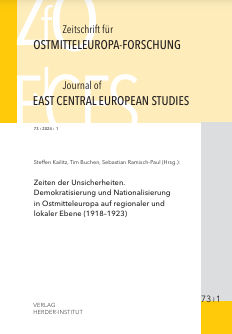Die „Plünderungen“ in Oberungarn im Herbst 1918 – bolschewistische Anarchie oder nationale Revolution?
The “Looting” in Upper Hungary in the Fall of 1918 – Bolshevik Anarchy or National Revolution?
Author(s): Miloslav SzabóSubject(s): Military history, Political history, Pre-WW I & WW I (1900 -1919)
Published by: Verlag Herder-Institut
Keywords: Upper Hungary; bolshevism; looting; World War I; Czechoslovakia;
Summary/Abstract: This article examines the significance of the so-called “lootings” (rabovacky) in Upper Hungary in the autumn of 1918, when receding soldiers and broad sections of the population attacked the representatives of state power and Jewish innkeepers stereotyped as “usurers.” In addition to their anti-Jewish character, their symbolic content, in which revolt against the old order was accompanied by carnivalesque violent mockery of it, is elaborated upon. The greatest attention, however, is paid to the political instrumentalization of the “lootings” on the part of the representatives of the new Czechoslovak state. This instrumentalization ranged from appropriation (albeit hesitant, given their violent nature) to condemnation: the former for the “Czechoslovak revolution” in the post-war years, the latter as a prelude to Bolshevization at the height of the economic crisis in the early 1930s.
Journal: Zeitschrift für Ostmitteleuropa-Forschung
- Issue Year: 73/2024
- Issue No: 1
- Page Range: 85-100
- Page Count: 16
- Language: German

